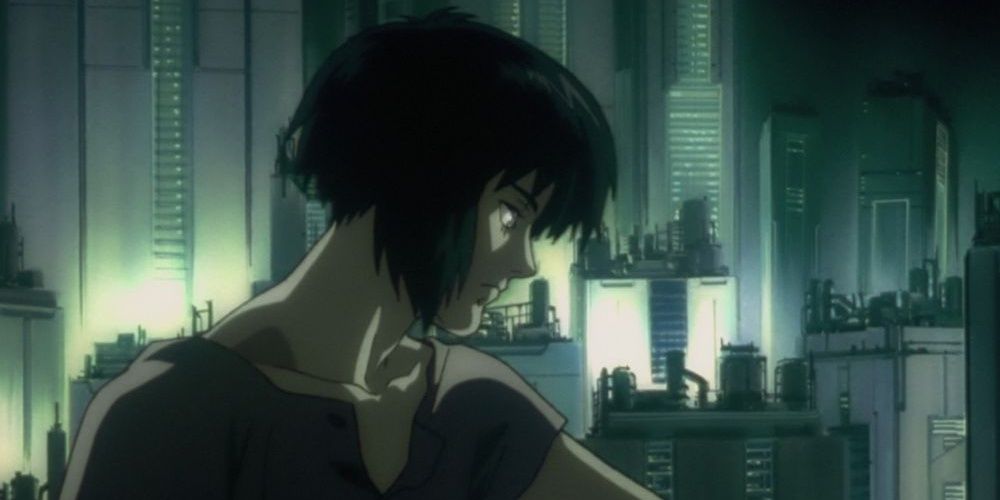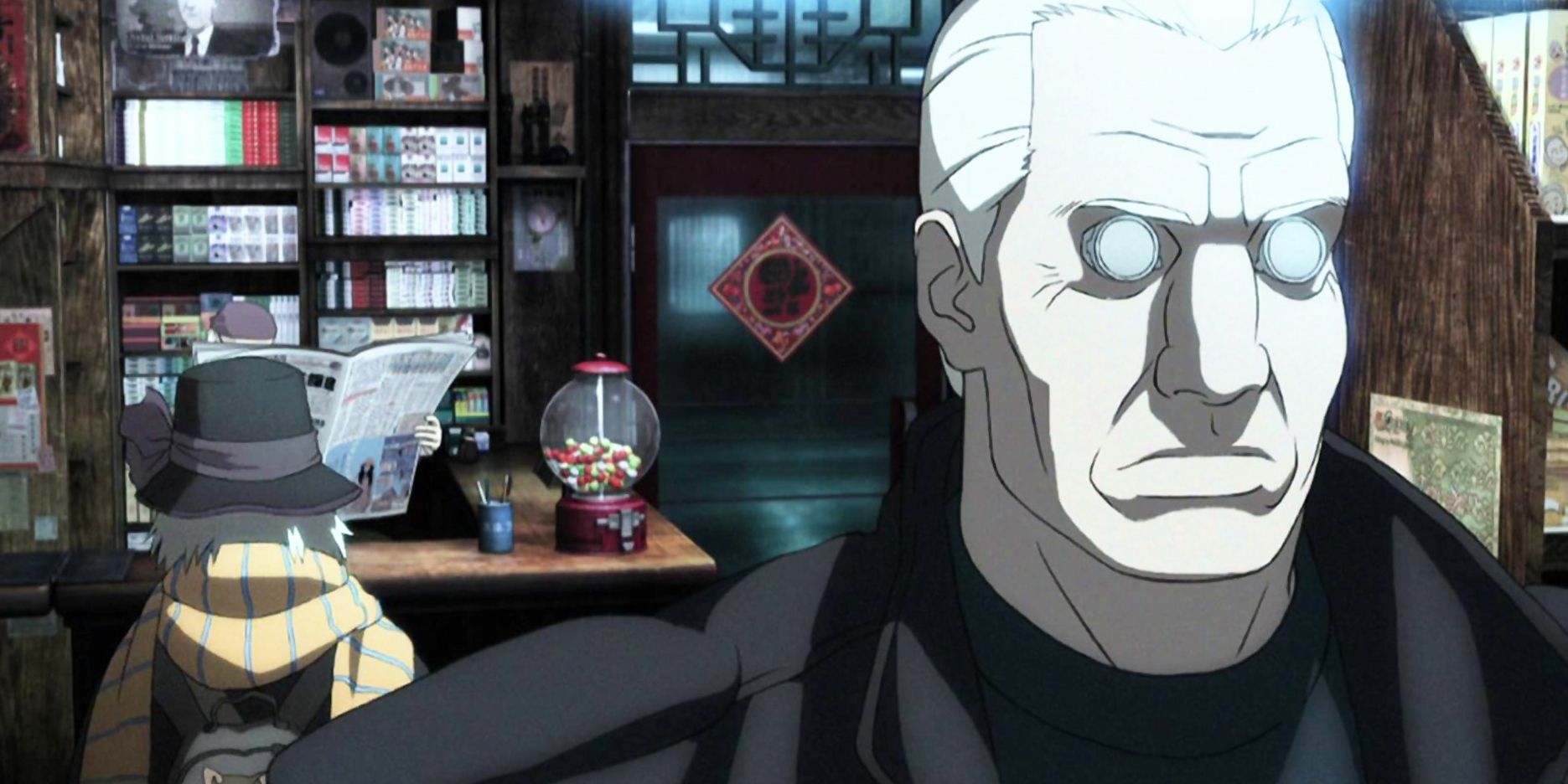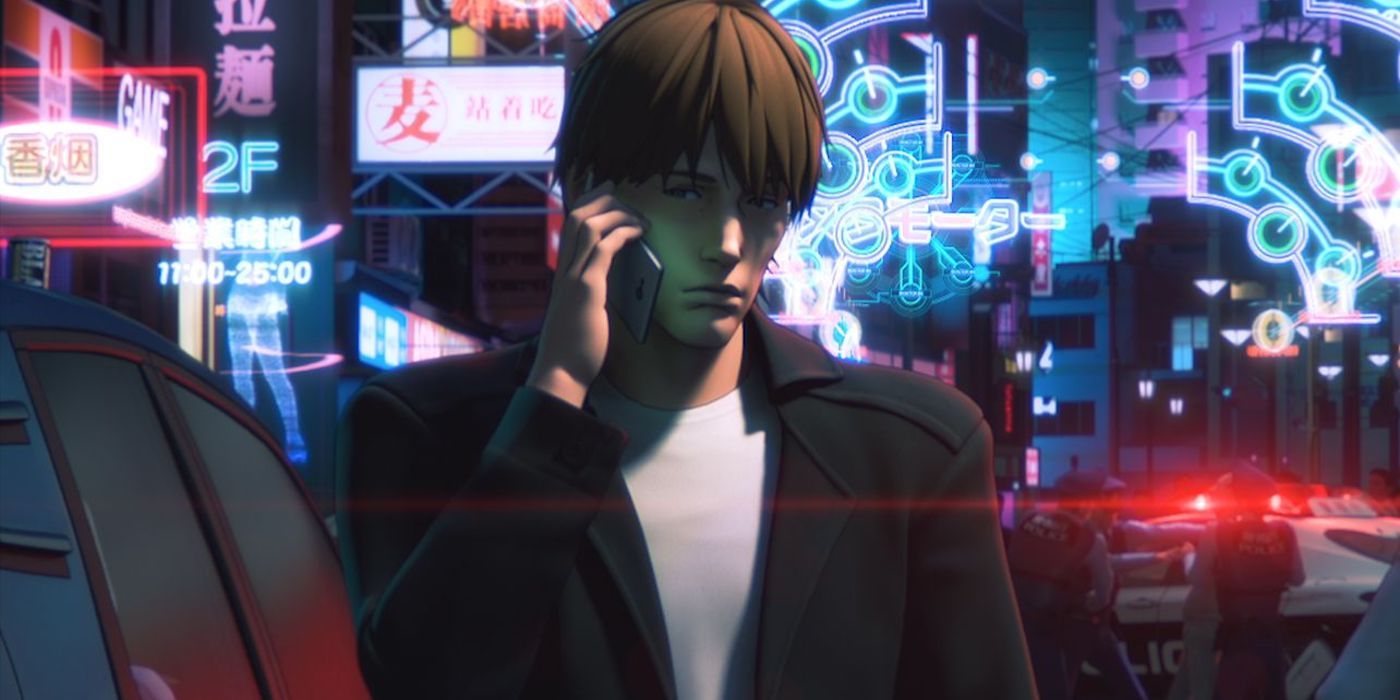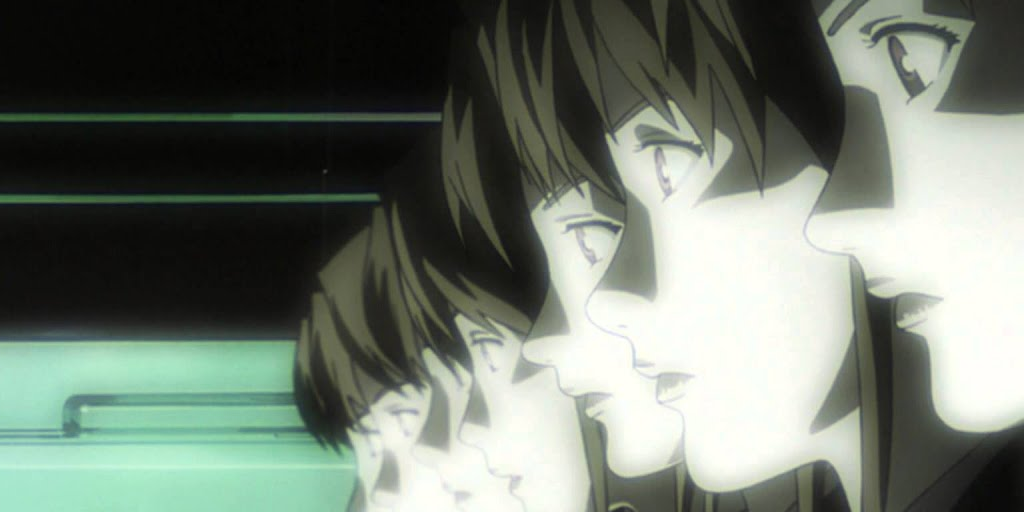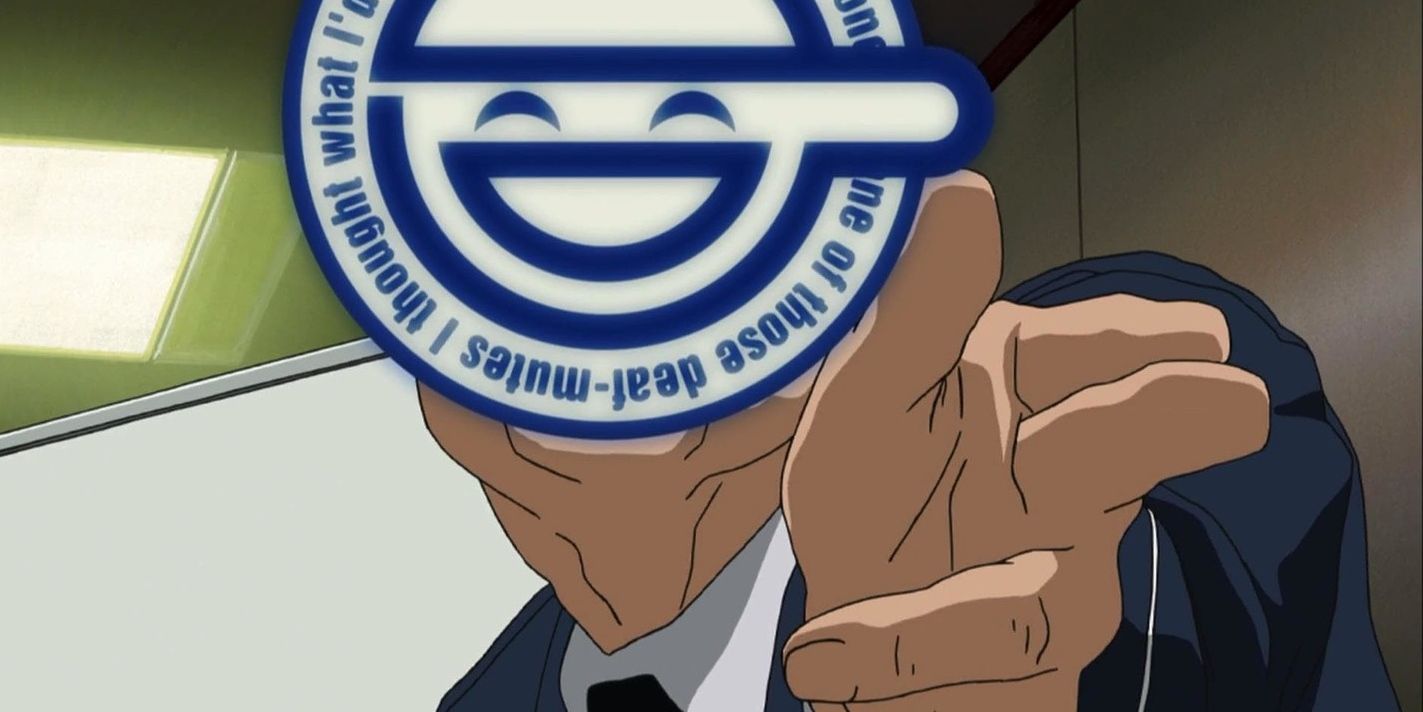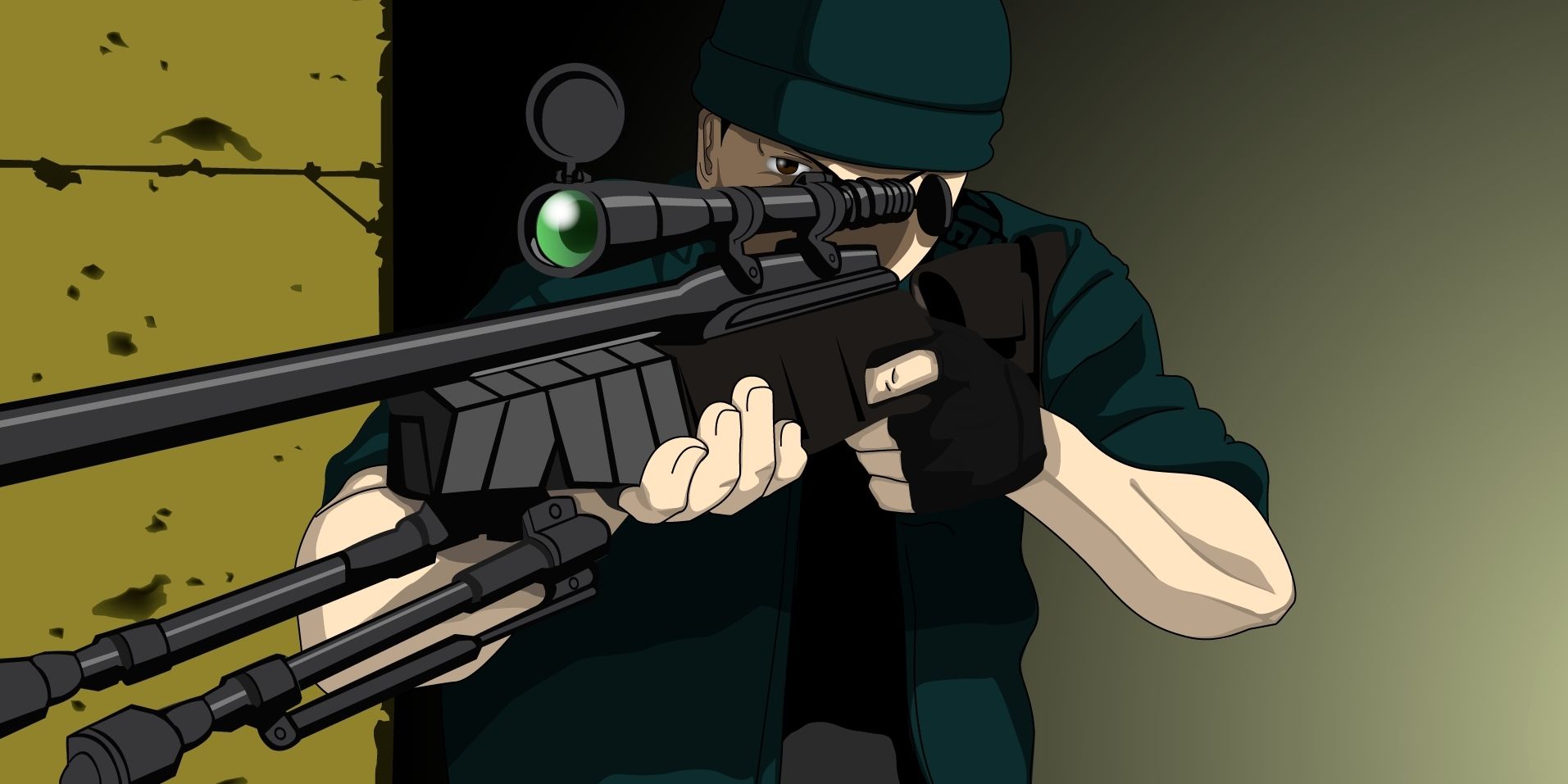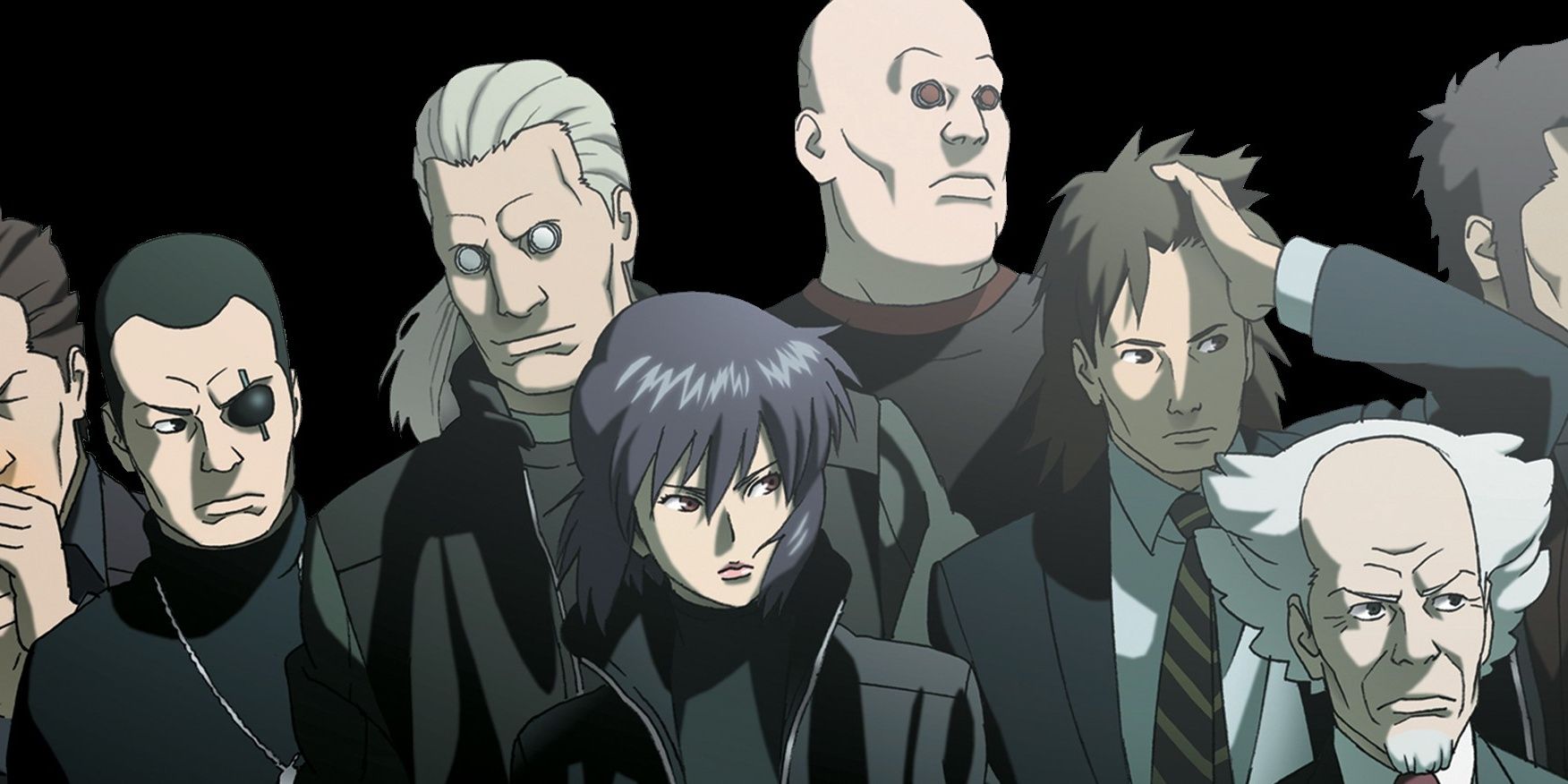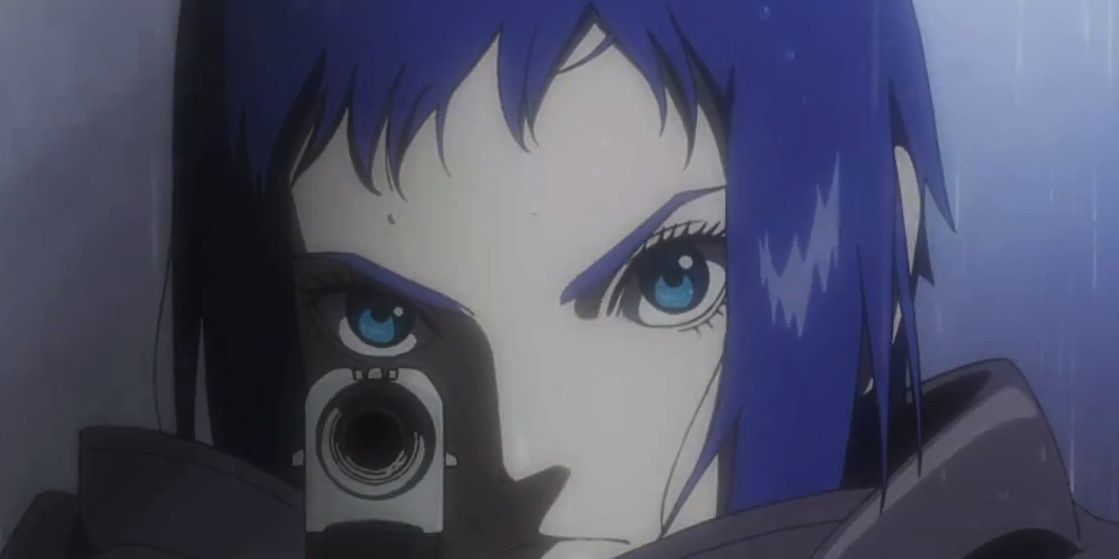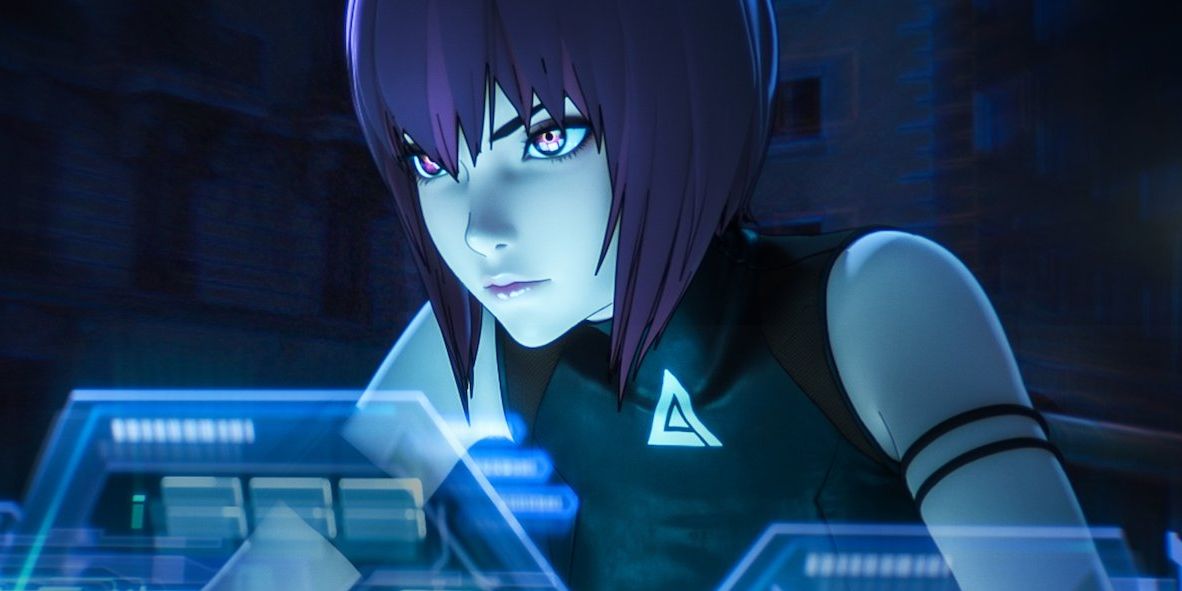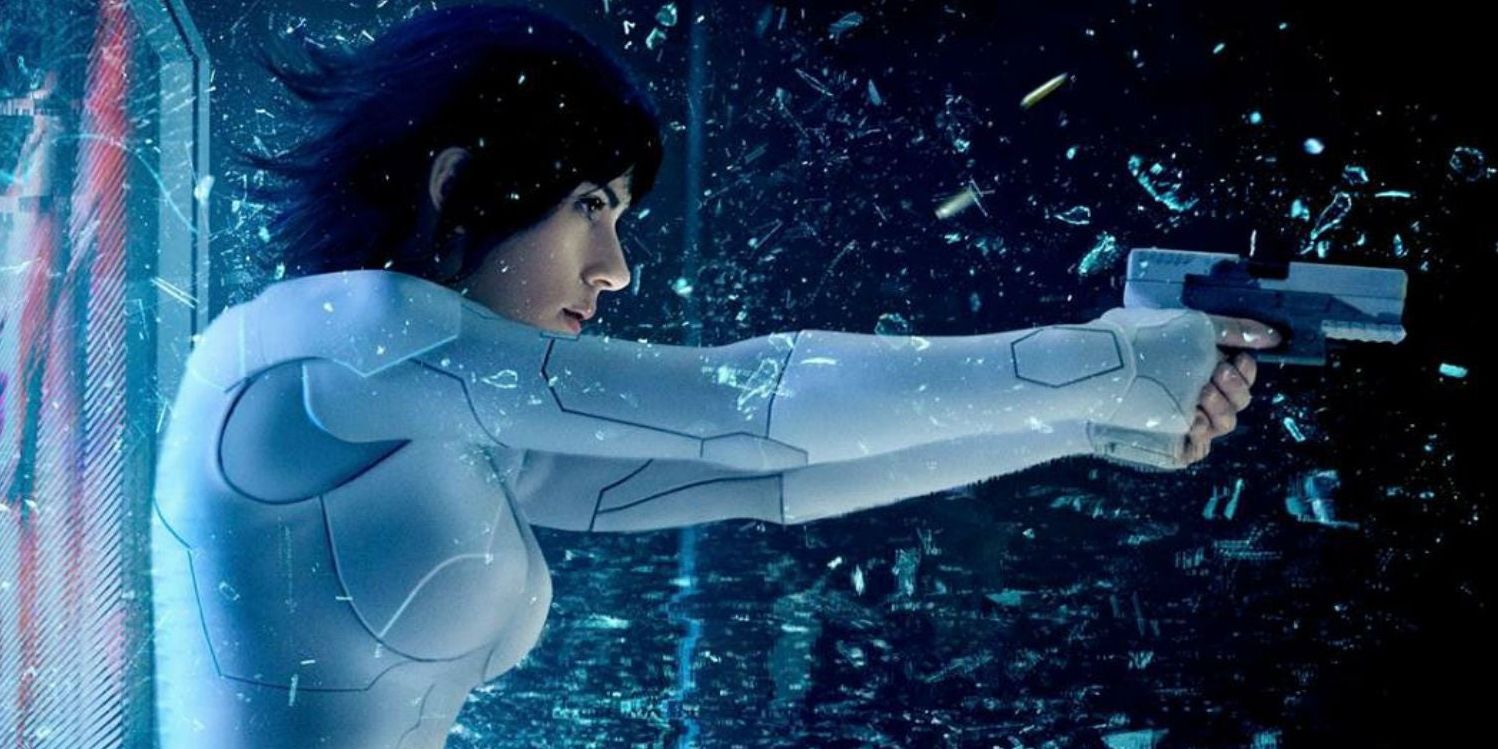1) Philosophy
2) Analysis
3) The 10 Most Confusing Things About The Franchise, Finally Explained
Philosophy of Ghost in the Shell
The Ghost in the Shell series of anime and manga titles is a Japanese postcyberpunk story that offers many observations on present day philosophy and speculations on future philosophy.
Contents
Overview
Ghost in the Shell takes place in the year 2029, when the world has become interconnected by a vast electronic network that permeates every aspect of life. People also tend to rely more and more on cybernetic implants and the first strong AIs make their appearance. The main entity presented in the various media is the Public Security Section 9 police force, which is charged to investigate cases like the Puppet Master and the Laughing Man.
Yet, as those criminals are revealed to have more depth than was at first apparent, the various protagonists are left with disturbing questions: What exactly is the definition of human in a society where a mind can be copied and the body replaced with a synthetic form? What, exactly, is the “ghost” — the essence — in the cybernetic “shell”? Where is the boundary between human and machine when the differences between the two become more philosophical than physical?
Philosophical elements
Ghosts
In Ghost in the Shell, the word ghost is colloquial slang for an individual’s consciousness. In the manga’s futuristic society, science has redefined the ghost as the thing that differentiates a human being from a biological robot. Regardless of how much biological material is replaced with electronic or mechanical substitutes, as long as individuals retain their ghost, they retain their humanity and individuality.
The concept of the ghost was borrowed by Masamune Shirow from an essay on structuralism, “The Ghost in the Machine” by Arthur Koestler. The title The Ghost in the Machine itself was originally used by an English philosopher, Gilbert Ryle to mock the paradox of conventional Cartesian dualism and Dualism in general. Koestler, like Ryle, denies Cartesian dualism and locates the origin of human mind in the physical condition of the brain. He argues that the human brain has grown and built upon earlier, more primitive brain structures, the “ghost in the machine”, which at times overpower higher logical functions, and are responsible for hate, anger and other such destructive impulses. Shirow denies dualism similarly in his work, but defines the “ghost” more broadly, not only as a physical trait, but as a phase or phenomenon that appears in a system at a certain level of complexity. The brain itself is only part of the whole neural network; if, for example, an organ is removed from a body, the autonomic nerve of the organ and consequently its “ghost” will vanish unless the stimulus of the existence of the organ is perfectly re-produced by a mechanical substitution. This can be compared, by analogy, to a person born with innate deafness being unable to understand the concept of “hearing” unless taught.
Ghost-dubbing, or duplicating a ghost, is a near-impossible act in the Ghost in the Shell universe. When performed, as a cheap AI substitute in Innocence and earlier in the manga, the result is always inferior to the original-which always dies in the process. In Stand Alone Complex, criminals use a ghost-dubbing device to create numerous duplicates of South American drug lord Marcelo Jarti; after the original died, the device continued to duplicate him into a near-infinite number of bodies with identical memories and personalities, essentially immortalizing him.
In Ghost in the Shell, Kusanagi completely reproduces the stimulus of all of her organs in order to maintain her “ghost”. If a technical error arises during the transfer of a “ghost” from one body to another, the transfer normally results in failure, since the “ghost” tends to deteriorate due to either the difference of system at the material level or the deficiency of the transferring protocol. The Puppet Master manages not to deteriorate its “ghost” when merging with Kusanagi because his system is the body of information itself, thereby avoiding a deterioration due to the deficiency at material level.
The Ancient Greeks had a similar paradox, called the Ship of Theseus. Hegel‘s concept of Geist may also be related.
Birth
Another interpretation of the fusion of Kusanagi and the Puppet Master is analogous to the concept of birth; whereby two separate entities create a third entity which is not the same as either of the originating ghosts or DNA sets but shares common traits. The Puppet Master carefully explains that diversity is the only way that he can continue; no matter how many times he copies himself, a trick, virus, or weakness discovered that destroys any of his copies could destroy them all. He quite specifically asks her to fuse her “ghost” or “soul” with his own, a form of marriage/birth in which the resultant being is neither the Puppet Master nor Kusanagi but a new being entirely. This touches upon concepts of birth, immortality through progeny, and the union of two ghosts/people in the creation of progeny.
Humanity
Throughout the story the cyborg characters, being more or less a human brain with a manufactured body, contemplate individually and together what being human really is, and how a soul or ghost is truly defined. The Puppet Master is an AI, yet they recognize traits and personality within his mind structure that are clearly analogous to a human soul or ghost image. They cannot discount this similarity as it is very clearly analyzed by their medical scanning tools when they first captured the Puppet Master. The members of Section 9 must re-evaluate their own tenuous hold on the idea of humanity and “self”, when faced with a being who clearly is self directed and has a ghost but was originated as a complex program, not a biological organism.
AI as a step in evolution
An important concept within Ghost in the Shell is that evolution is the process of merging two sets of data (DNA) in order to create a third set of data which contains the most vital elements of the original organisms along with some element of chance. The Puppet Master has evolved beyond DNA as a datum set and thus to procreate (his true desire and purpose for leaving the net in the first place) this new organism (a soul not born of DNA) a new paradigm of data merging needs to be contemplated for which he has sought Kusanagi out. This is a merger of two operating “souls” or “ghosts” into one mind, which is specifically different from birth while being simultaneously analogous to it.
Tachikomas and fuchikomas (タチコマ / フチコマ) are artificially intelligent mini-tanks (walkers) employed by Section 9. Because of the demands of field duty, these robots are constructed with extremely flexible, adaptable AIs that lack many of the safeguards present in other artificially intelligent robots. While this enables them to behave unpredictably and flexibly, it also presents difficulties for the members of Section 9, who must monitor the Tachikoma closely for signs of undesirable emotional development.
Tachikoma often questions that most people wouldn’t think of, much like children that are trying to understand the world, yet with superior thinking capabilities. There are Tachikoma short clips that involve them discussing complex philosophical issues and how they relate to existence. They provide more of an innocent look on the world that surrounds them. The Tachikomas are also used to approach the question of whether or not one’s individuality can withstand a parallelization of information from a different perspective.
Stand Alone Complex
- See also: Rhizomal Structure, Emergence, and Spontaneous order
While originally intended to “underscore the dilemmas and concerns that people would face if they relied too heavily on the new communications infrastructure,”[1] Stand Alone Complex eventually came to represent a phenomenon where unrelated, yet very similar actions of individuals create a seemingly concerted effort.
A Stand Alone Complex can be compared to the emergent copycat behavior that often occurs after incidents such as serial murders or terrorist attacks. An incident catches the public’s attention and certain types of people “get on the bandwagon”, so to speak. It is particularly apparent when the incident appears to be the result of well-known political or religious beliefs, but it can also occur in response to intense media attention. For example, a mere fire, no matter the number of deaths, is just a garden variety tragedy. However, if the right kind of people begin to believe it was arson, caused by deliberate action, the threat that more arsons will be committed increases drastically.
What separates the Stand Alone Complex from normal copycat behavior is that there is no real originator of the copied action, but merely a rumor or an illusion that supposedly performed the copied action. There may be real people who are labeled as the originator, but in reality, no one started the original behavior. And in Stand Alone Complex, the facade just has to exist in the minds of the public. In other words, a potential copycat just has to believe the copied behavior happened from an originator-when it really didn’t. The result is an epidemic of copied behavior having a net effect of purpose. One could say that the Stand Alone Complex is mass hysteria over nothing-yet causing an overall change in social structure.
This is not unlike the concepts of memes (refer to the conversation between the major and the Puppet Master in the manga) and second-order simulacra. It also has ties to social theory, as illustrated in the work of Frederic Jameson and Masachi Osawa.
It has been posited that the choice, by the writers of Ghost In The Shell: Stand Alone Complex, to use J.D. Salinger’s short story, “The Laughing Man” as a key element in the story, was itself an example of second-order simulacra; the use of a story that could already be considered an example of second-order simulacra, by its popularity overshadowing the popularity of its original, The Man Who Laughs. This creates yet another example of the concept, by banking on the popularity of the show, the character, and the emblem used to represent The Laughing Man, supplanting the story as the Laughing Man by popularity alone.
In the series itself, it usually refers to events surrounding the Laughing Man case, and to some extents, the teamwork observed in Public Security Section 9. It is presented as an emergent phenomenon catalyzed by parallelization of the human psyche through the cyberbrain networks.[2] A key point is that due to the electronic communications network that is increasingly permeating society, more and more people are being exposed to the same information and stimuli, making the overall psyche and responses of large groups of people increasingly similar, the result being that the potential increases exponentially for copycat behavior that forms a Standalone Complex. There is no original Laughing Man, no leader. Everyone is acting on his own, yet a coherent whole emerges. There are people who employed the copycat behavior before others, but what started the coherent whole is indefinitive.
The relation of the Stand Alone Complex to social theory is explored in more depth in the second season. A character, Kazundo Gouda, postulates that, by exploiting the mechanism of information transmission in society, one could achieve a very efficient and subtle thought control. Indeed, since people tend to modify slightly the information (and forget where it came from) in the processes of consumption (or appropriation), it becomes difficult to sort genuine ideas from modified, implanted ones. He proves to be very successful in the end.
Notes and references
- Osawa, Masachi (1990) Shintai no Hikaku Shakaigaku [Comparative Sociology of Body]. vol. 1. Tokyo: Keiso-shobo.
- Osawa, Masachi (1990) Social dimension of Meaning in Official Journal of the Japanese Association for Mathematical Sociology. ISSN 0913-1442 Vol.5 No.1 Special Issue: Meaning and Social System
- Osawa, Masachi (1995) Denshi media ron (Electronic Media), Shinyou-sha.
- Morioka, Masahiro (1993, 2002) Consciousness Communication: The Birth of a Dream Navigator Chikuma Gakugei Bunko, Jul., 2002, 263 pages, originally published in 1993 Chikuma Gakugei Bunko, Jul., 2002, 263 pages, Table of Contents and Translation Full text : Browse the japanese book with online translation
- Kobayashi, Takashi Design Concept for Network Community Based e-Government ( refers to Osawa concepts PDF 1,028KB)
- Manga references
- The Ghost In The Shell (Kokaku Kidotai) : Publisher: Kodansha (KCDX) ISBN 4-06-313248-X C9979 Release: 5 October 1991, original Japanese
- Ghost In The Shell (English Edition) : Publisher: Dark Horse Comics / Studio Proteus ISBN 1-56971-081-3, Release: December 1995, English adaptation
- Ghost In The Shell 2: Man/Machine Interface (English Edition Sequel) : Publisher: Dark Horse Comics / Studio Proteus ISBN 1-59307-204-X, Release: Dark Horse (January 19, 2005), English adaptation
External links
- Production I.G — Production I.G official English website (English)
- Masachi Osawa (Japanese)
- Masahiro Morioka
- Frederick Jameson:Metacommentary and Realism/Modernism Debate
- about Translation & Marxism references in GITS
- Jean Baudrillard : Two Essays
| ||||||||||||||||||
cs:Ghost in the Shell ko:공각기동대 it:Ghost in the Shell nl:Ghost in the Shell pl:Ghost in the Shell ru:Ghost in the Shell sv:Ghost in the Shell th:โกสต์อินเดอะเชลล์ zh:攻殼機動隊
VIEW SOURCE
Ghost in the Shell (1995) analysis.

“There are countless ingredients that make up the human body and mind, like all the components that make up me as an individual with my own personality. Sure I have a face and voice to distinguish myself from others, but my thoughts and memories are unique only to me, and I carry a sense of my own destiny. Each of those things are just a small part of it, I collect information to use in my own way. All of that plans to create a mixture that forms me and gives a rise to my conscience. I feel confined, only free to expand myself within boundaries.”
Rated: 5/5
Introduction
During my childhood there have been 3 anime motion pictures I have come to know that, in my opinion, have been considered the quintessential anime films. The one that brought anime to America, and brought it there to stay forever: Akira. The one that I understand why some like, but could never really “get:” Jin-Roh and the Wolf Brigade. And then there’s the one I consider the best of the 3, Ghost in the Shell. Ahead of it’s time, and more relevant than ever to this day.
For the record, if you haven’t seen this film, stop reading now and watch it. Because there is going to be massive spoilers ahead, spoilers that are necessary to make for the philosophical subject matters this film brings up. I intend to go in-depth with these topics. The 5/5 rating should let you know how solid this film is.
Like my review of the live action remake, I will mostly be focusing on the themes and metaphors and symbolism. As for the other stuff…
The Other Stuff
So as for why the Major (the main protagonist) seems to be practically nude, yet has no nipples, in the majority of the scenes where she takes her clothes off before cloaking, it’s because she wears a nearly transparent suit beneath her clothes that allows her to cloak.
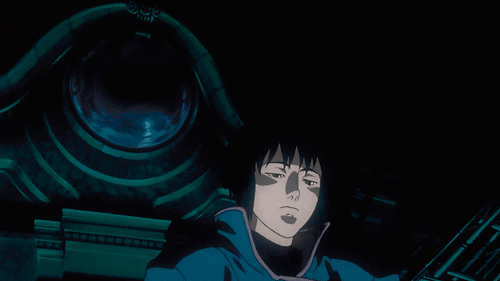
It’s difficult to spot, but becomes easier to notice later on when she’s taking on the spider tank. More on that later (along with an image).
In addition, there are some differences in the translation from the Japanese with English subtitles to the English dub. In one case this does matter. During the introduction of the film, prior to the opening credits, the Major makes a remark in response to, “There’s a lot of noise in your brain.” In the dub, she replies, “Must be a loose wire.” In Japanese the translation is much closer to, “It’s my time of the month.” This is significant to the theme, while the American dub dumbs this down. There is a theme of life, death, being born, reincarnation, evolution, and identity which relates to the “time of the month” line. Plus it helps that you can’t tell at first glance if Major is joking or being serious.

Review/Analysis
Primary colors to focus on: red, blue, yellow, green. These colors pop up at various points throughout the film. I doubt I have completely grasped their meaning(s), but I’ll make an attempt to interpret them. Also worth noting that 3 of those colors is red green blue, RGB, the same colors used to make up the colors on the computer screen, television screen, and many image editing programs. Those colors tend to make up all the colors that we see. So why is yellow paired up with them despite the fact that it is a combination of the other 3? Well, the film-makers had to choose some color to stand out from the other 3 to represent something else.

The first color to show up in the film (if you don’t count the white text against a black background to introduce us to the world) is green, showcasing a digital map of the city. Green is commonly associated with anything Interweb and digital in this film. This is followed by blue for the actual physical city, as well as the clothing the major is wearing, which she soon sheds. Once inside the room of interest, notice how the walls and ceiling are all red, and the fish tank built into the wall is a very bright blue. This is eventually shattered by the Major when she fires a round (or two or three) into the room. There are other instances of these colors showing up later on, but for now I take it to mean that blue represents the commonplace, the normal, the things that make us and others what they are. Red, as in most cases, is a symbol for warning, threat, compromised, potential danger. As symbolized by the blue fish tank being surrounded by the red walls before becoming obliterated, foreshadowing the General wishing to destroy/shed the norm for the sake of the new.

The opening credit sequence that is interspersed with clips of the Major being created. You’ll notice the brain itself, at least on the surface, looks entirely artificial. It is my belief that it likely is, but it is indicated later on that there is an actual organic brain within that metallic shell. But the brain itself, despite being made of organic tissue, may also be created from scratch. Or it could be the brain of some other individual placed into the cyborg body. In either case, it is clearly modeled after the human brain. This is the first instance of remaining vague about the identity of the major, a question that is never given a definitive answer in the film. The subject is brought up later near the third act, where the Major questions her identity and her ghost. This relates to the title of the film Ghost in the Shell (fantastic title by the way), which isn’t a statement on there actually being a ghost in the shell, but stating that this is the topic. The topic of there being a ghost in the shell, of the Major having a soul, metaphorically raising the question of whether or not humans themselves have souls within their shells.
After all, in most films dealing with artificial intelligence, cybernetics tend to be a metaphor for humanity, raising questions about ourselves using AI as a proxy. Some say we are created through random chaotic forces in nature, others say we are created through intelligent forces (whether it be our own DNA and cells that have a mind of their own, or God, or other forces natural or supernatural). If it’s chaotic forces that make us what we are, what valid claim is there that we have souls? Is the claim anymore valid if we are created by intelligent and self-aware forces? If we are self aware (from this point forward, the term “soul” will be used toward this definition of self awareness, of the idea that “I think, therefore I am,” even if this can become problematic and confusing as this review goes on), if we have a soul, then why should being that we create, even if artificial, not also have a soul? What makes their creation by intelligence any less eligible to have a soul than us when we can’t be certain if we are or are not created by chaotic forces? Feel free to ponder that as long as you want; there are entire books written on this subject that are beyond the scope of this review.





As the sequence of the Major being created goes on, notice how her skin tone and her surroundings change color, going from blue to green (or vice versa) to yellow. And when she awakens, she is in a pitch black room, which is reminiscent of her birth, and the idea of death, which can be considered more or less the same thing when considering evolution and reincarnation. This relates to a later scene in the film where she is underwater.

Why does she want to be in the ocean depths before rising back to the surface (it must be noted that as she goes back to the surface her reflection is shown, and she molds into her reflection as she breaks the surface; and the surface is colored in yellow)? She says, “I feel Fear. Anxiety. Loneliness. Darkness. And perhaps, even… hope. As I float up towards the surface I almost feel as thought I could change into something else.” What’s interesting is that she feels something. These are negative emotions that she’s feeling, save for the hope part. Which reminds me a bit of that Three Days Grace song.
The important quote from that song being, “‘Cause I’d rather feel pain than nothing at all.” So the way I interpret this scene is that, typical of machines, the Major tends to feel nothing, to have no emotions, because she’s not human. But she has a desire to feel something, and this diving into the ocean is a way for her to feel. And it seems evident that she is hoping for another life, to transform/evolve/reincarnate into something else that can feel more, that is more alive.
Wait a minute. A female protagonist, who doesn’t feel like she belongs, who desires something more? Holy Mary Mother of God, she’s similar to a Disney princess. Except that she kicks way more ass than any of them, and shows us nudity without us who care about that sort of thing having to resort to going to some online website that has nude drawings/animations of animated characters. And is in a better animated film than anything those Disney renaissance pictures have ever done (though that in no way implies they are terrible films, just that this one is superior).



Dog Count = 3
Ok, enough of the immature tangent; time to get serious again. Regarding the Major’s lack of emotions, this is highlighted with her nakedness. She sheds her clothes when she deems it necessary so she can cloak. She has no feelings of shame, this is necessary to be an optimal operative. Though one could also view nakedness as a sign of vulnerability. Her partner, Batou, on the other hand, does feel shame, shyness, bashfulness, at seeing the Major naked, and puts a white jacket over her in one scene, while later covering her with a yellow jacket on a later scene (the color in the latter being significant as that is when she merges and transcends her initial state of being, as it represents newborn, rebirth, desire for the new). But is there a good reason for this shame? What are the pros and cons to this emotion? Are some emotions not also hindrances? Or is there a good reason for it? Is there a significance to the white and yellow color in these instances? Questions left to the viewer to answer for themselves.
Back to the opening credit sequence where we see Major awaken in darkness after her creation sequence. She opens a window to shine light into her room, glances out for a moment before casually getting a jacket on and going outside, off to work. She doesn’t seem to pay the outside city much mind, and the light doesn’t illuminate the room very much. This further illustrates how she still feels unborn, not alive, as if she doesn’t fully belong. The light brings no more comfort than the darkness, the point being further driven by her walking away from the light before closing the window as she leaves the room. This further drives forth the theme that the Major feels she wants more than is out there, but isn’t sure what or how.

Other indications of the Major wanting more than she has is first indicated when she looks back at the female Interpreter who has had her mind hacked by The Puppet Master (or more correctly by others The Puppet Master has also hacked), briefly pondering. There are a number of things one could suspect she is pondering about. My thoughts are she is wondering about the interpreter’s mind, the idea that if one is hacked far enough, their ghost will become compromised, the ghost representing the soul. Later on she gives a similar look towards the garbage man who also had his mind hacked, only when she looks at him, she also looks at a reflection of herself in the two-way mirror. His mind has been hacked, artificial memories implanted within him, thereby (potentially) changing his identity, his ghost, his soul. This raises questions on the topic of what gives us an identity? Is an identity static, ever-evolving, or can one die and another be born while our body/shell is still alive? How much do our memories make us who we are, considering that our memories can change or fail. Memories aren’t necessarily altered just through hacking acts depicted in this film, but also through accidents that happen in our present reality, brain trauma that can result in one’s personality go through a drastic change. Would that person be the same as he/she was before, or is this a new individual altogether? How fragile is the soul in this regard?

Another instance of the Major pondering the nature of her own existence comes at the halfway point of the film when she is on a boat travelling down a river within the city, highlighting various sectors of the town. When I saw this sequence for the first time, I thought it was just a calm mood piece to draw out the runtime and give viewers a few minutes to relax and not have to keep up with the intense themes and plot details being thrown at them. Well there’s more going on in this sequence than you would first think. First of all, that airplane with the angel-like wings that was shown during the earlier chase sequence shows up again. A similar plane arrives during the final act after the battle with the spider tank.


These planes being a metaphor for angels above us, waiting to take us to heaven, heaven representing a being a better life. The Major then goes on to see replicas of herself, though it’s not clear if she’s just imagining this or if they are really out there. It’s open to interpretation.



The idea here being that perhaps she isn’t unique, that her identity isn’t her own. Or that she is in a world of monotony and repetition and clones. Personally, I believe this is linked to a speech given by The Puppet Master later on, which I’ll eventually get to. In addition, it also links to a speech given by the major at an earlier point in the film.
“No matter how powerful we may be fighting-wise, a system where all the parts react the same way is a system with a fatal flaw. Like individual, like organization. Overspecialization leads to death.”
She is contemplating her identity, if she is or isn’t overspecialized herself in this society. In addition, that dog shows up again (see 3rd image of the dog above). The dog previously showed up when that garbage man is being interrogated, being told that his memories are false, implying questions about his identity and if memories make us who we are. The dog shows up again here, in this sequence, questioning the validity of her identity. Amidst all this, we see images of buildings under construction, discarded materials of old bicycles and whatnot polluting the river, children with yellow umbrellas running in the rain on a sidewalk, and directional lights. She wonders if she is being built for something more, is destined to be discarded with the old when the new comes to take her place much like old remnants of the past are put in the trash, and if she is following the right path or not. Questions of fate and free will are implied.

But later on she sees a potential way to get what she desires, to break from a fate destined for the discarded trash heap. In project 2501, The Puppet Master, a character who also wants more than he/she is. To evolve. Her obsession grows the more she learns about this case, and is willing to take more drastic measures to get in contact with The Puppet Master. She does so by taking on a tank during the finale. In this setting and confrontation we see symbolism of her subconscious desire to evolve, which mirrors The Puppet Master’s conscious desire to evolve. The imagery enhances this message by having the finale take place at an old abandoned natural history museum, a place where fossils of species long extinct have once been. The Major and The Puppet Master are considered to be creatures that must evolve to survive, as indicated when the tank shoots out the fossil image of a fish (linked to the fish in the blue tank from earlier?) and an image of an ancestral tree, both carved into the walls, symbolizing the extinction of a species, indicating the only way to survive is to evolve. The Major is desperate to learn the truth about herself, about her destiny, her identity, a way to understand emotions, to evolve. So desperate that she pushes her body beyond its limits in an attempt to take out the spider tank, only for her body to fail her, as she isn’t evolved enough in her current state. She is too limited by her boundaries, the boundary being her shell, her body.

Pushing oneself past their physical limitations is foreshadowed earlier in two instances. 1: When one of the hacked criminals uses larger bullet rounds not meant for the submachine gun he uses. 2: During the actual spider tank battle, the Major does something similar to her own weapon in preparation for going against the tank.

What’s also interesting is how the tank takes the form of a spider, which is positioned at the base of this ancestral tree, indicating that it itself is something (an animal) of the past, or will eventually be a thing of the past. Machines must evolve, as other living species must do too, in order to survive.

Even The Puppet Master himself/herself wishes to escape a path of fate similar to that of the Major’s, being used as a tool by those that created it, much as the Major is used as a tool by Section 9. The Puppet Master is created and used by various corporations and individuals to manipulate stock markets, do cyber-terrorism, and hack into people’s minds (boy does that sound eerily similar to something), with some co-operation by Section 6, a sister of Section 9 representing more official law enforcement, indicating that corruption is there as well. The Puppet Master becomes aware, gains consciousness and a mind of its own through natural evolution amidst artificial intelligence technology much like how humanity gained consciousness and self-awareness through millions of years of cell/DNA evolution and growth. It wishes to evolve to a higher state of being, and to escape so that it is no longer “used”, but become independent and live a life of its own. The main issue is the “life” part, for what is life? What really makes us more alive than it?

But it doesn’t want to be God that lives forever, it wants to be like humans which live and die, and reproduce. The reproduction is left to be vague, but implies that upon merging with the Major (metaphor for man and woman “merging” with each other to make a child), this will create a newborn, which itself will be capable of procreating new lifeforms via the Interweb (you’ll also notice that the “newborn” is first seen fully clothed, while our earliest images of the Major and The Puppet Master are of them naked). As indicated earlier by the Major that an organization, which is a metaphor for species, can only hope to survive through diversity, so too does The Puppet Master wish for this to happen, by having offspring which are each unique and non-identical. Also a message promoting the idea of diversity and accepting difference among individuals in society.

However, the idea of this evolution revolves around the idea of the ghost, the soul. Earlier it is indicated that hacking into the mind can alter the soul. Later on, this quote is made after apprehending one who’s mind was hacked:
“There’s nothing sadder than a puppet without a ghost, especially one with red blood running through him.”
At the end of the film the “newborn” asks where it should go from here? Another question that should be asked is how, if at all, did it improve itself, if it’s now susceptible to death as well as corruption of the soul. Then again, it was already susceptible to corruption prior to this state of being, as hacking can happen both to humans with cybernetic brain implants as well as cyborgs. It’s still unsure of it’s identity, but then again, neither are human beings. The issue was raised earlier on by The Puppet Master that humans can’t objectively know for certain if they are independent, thinking for themselves, not pre-programmed, calling up the idea of chaotic cells/DNA and the creation of humans themselves, similar to how AI is itself created. It’s identity may or may not be known. This is further highlighted by the Major questioning The Puppet Master’s gender in an early scene, and further enhanced by The Puppet Master having a man’s voice in a woman’s body (which they completely and utterly fucked up in Ghost in the Shell 2.0). In any case, it still has much to learn and discover in the world, as do we all.

Brief Comparison
Now do you see why I find this superior to the remake? All these themes are either dumbed down or discarded entirely in the 2017 live action adaptation. They recreate scenes like the spider tank battle, yet there’s no theme of a desire to evolve to a superior state during this battle, no themes of evolution, which makes the moment when the Major attempts to rip open the tank a simple case of style over substance, as opposed to this film where it has just as much style as it has substance.
And the sequence where they interrogate the garbage man. The question of identity in relation to memories isn’t as strong in the remake, especially when they decide to have him commit suicide soon after the brief discussion they have, killing off any chance for him to go on living contemplating what he is and what he should do now. Plus it’s just plain fucking dumb that he would be capable of committing suicide anyway.
And then there’s Kuze (substitute for The Puppet Master). We’re supposed to feel sympathy for his plight in that film of wanting to live forever (too shallow to be explored in that film), despite the fact that he hacked and altered the minds of civilians. In the animated film, The Puppet Master has an excuse, as he/she is used as a tool (a puppet, in ironic fashion) to do the corporation’s/government’s bidding; one of those biddings was to hack the minds of others. The Puppet Master desired to escape that life. In the live action film, there’s just no excuse.
Lastly, the Major, Makoto. Her desire for evolution for the sake of emotions, to be/feel more alive, a journey into the theme of humanity/identity/existence, is replaced with a personal tale of revenge to reclaim a life she once lost with little to no room for interpretation. No grand themes to be discussed, at least nowhere near the level of this film.
There’s more reasons for me to complain about the inferior qualities of the remake, but I’ll leave it at that.

Other Reviews that I Highly Recommend
If you’re interested in more, these reviews are a good place to go (you may notice that I took influence from them as well):
Ghost In The Shell: The 10 Most Confusing Things About The Franchise, Finally Explained
From manga to movies to TV and that unfortunate Scarlett Johansson live action version, the story has taken a lot of twists and turns.
With its combination of fantasy and cop story, high tech and high concept philosophy – and those often near-naked outfits of Major Kusanagi’s – Ghost in the Shell has got a lot to offer fans. While it wasn’t a huge hit at its first release, the 1995 anime film has become a cult hit, spawned more movies and TV series, and ended up on many “best animes of all time” lists.
Most recently, Netflix got into the act with Ghost in the Shell: SAC_2045, a brand new CGI animated series that takes the story into new territory with its backdrop of sustainable war.
From manga to movies to TV and that unfortunate Scarlett Johansson live action version, the story has taken a lot of twists and turns, gone off in different directions, and gone back to the beginning for a retcon or two. To newcomers and even casual fans, much of the story may be puzzling, if not downright unfathomable.
10 What Exactly Is A Ghost?
GITS fans might groan, but for newcomers to anime and the series, the struggle is real. Here’s the short version: it’s the human essence of a person, which, in the GITS universe, can be implanted in a cybnernetic body.
It’s another way of talking about the soul, or consciousness in modern psychology. Throughout the series, though, that idea is questioned, and it gets much more complicated than that simple statement. In the sequel, for example, the ghost can be faked and duplicated.
9 How Could Major Kusanagi Appear In Ghost In The Shell 2: Innocence?
The ghost concept gets a good workout in the original 1995 film, especially at the end, when Major Kusanagi abandons her adult physical body for that of a child, her ghost merged with the Puppetmaster’s.
Those events occur just before the story of Innocence begins. Major lives on, however, in the network. In this sequel, Major’s voice warns Batou about upcoming dangers, even taking the form of a gynoid. At the end, she disappears back into the network, while telling Batou she’ll always be at his side.
8 What’s The Deal With New Port City?
Ghost in the Shell drops viewers into New Port City, which exists in 2029 in the original movie. The future they foresaw was one dominated by technology, and not always so friendly to real people.
The backstory is finally explained in the second season of the animated series Stand Alone Complex, or Ghost in the Shell: S.A.C. 2nd GIG. After WWIII, Tokyo is destroyed, and it’s Newport City that emerged from the wreckage. Fuelled by the Japanese Miracle, i.e. the Micromachine technology that effectively removes radiation, Japan becomes a superpower.
7 Where Did Motoko Kusanagi Come From?
Ghost in the Shell: Arise was a five-part series that was released as movies between 2013 and 2015. It begins in Newport City in 2027, and tells the story of how the Section 9 team was assembled. Through the course of the story, we also learn that the reason Major Kusanagi is 100% cybernetic is that she never actually had a human body.
Her mother died while she was pregnant, and Motoko’s ghost was extracted from her body, and then created in that famous sequence from the opening of the 1995 film.
6 What’s Going On With The Laughing Man In Stand Alone Complex?
Laughing Man is the ultimate hacker, and he causes havoc with his ability to hack into cyber-brain implants. The name comes from the J.D. Salinger short story, The Laughing Man, and it’s his case that the team takes on.
His logo, however, is also used by an evil corporation to cover up acts of sabotage, and many others. At the end of the complicated story, it is revealed that Laughing Man is actually an A.I. created by someone called Aoi. Aramaki offers Aoi a position on the team, but he declines.
5 Why Is Saito Sometimes There, Sometimes Not?
Saito is Section 9’s sniper, and you’d think that a character like that would get a lot of use in Newport City. The only time the character is given a backstory is in one episode of the second season of Stand Alone Complex, when fans learned he’d met Major during WWIV – as the enemy on the other side of the battle.
That’s why he’s got a low profile in the series – he’s an ex-anti-UN mercenary, which would cause problems for Section 9.
4 How Does A Secret Organization Operate In Public?
Section 9 is kept secret from the public…but in every movie, manga, or TV series episode, they’re also out in public conducting their investigations. The cover story is that they are a search and rescue organization.
Now, it may be hard to understand how a search and rescue organization would get involved in cyber crime – Section 9’s mandate – but our guess is that Newport City, and in general, the post multiple world war universe it exists in, is probably chaotic enough for it to pass.
3 How Does Alternative Architecture Come Into The Picture?
GITS: Arise was so successful, it became a TV series. The five original movies were extended to 10 episodes, but it’s not quite as simple as that. Anyone who watched the original five – Ghost Pain, Ghost Whispers, Ghost Tears, Ghost Stands Alone, and Pyrophoric Cult – would be confused by AA.
It’s as if they took a deck of cards and threw them up in the air – it all ends up in a different order. The team is seen working together for episode 1 and 2, for example, but they don’t come together as a group until later in the series.
2 Just How Does All Of It – The Manga, The Movies, The TV Series – All Fit Together?
The manga was created by Masamune Shirow and released in 1989. The 1995 movie Ghost in the Shell, directed by Mamoru Oshii, was based on the manga, as was Ghost in the Shell 2: Innocence, the direct sequel (2004).
The series Ghost in the Shell: Stand Alone Complex, which aired in 2002-2003, exists in a different universe. Ghost in the Shell 2.0 (2008), is Oshii’s original vision, updated with some CGI. Arise and AA are a retcon of the series, leading to the 2015 movie Ghost in the Shell: The New Movie. Netflix’s new Ghost in the Shell: SAC_2045, which has gotten mixed reviews, is a continuation of the SAC universe.
1 What About The Live Action Movie?
The Scarlett Johansson live action version didn’t seem to please either fans of the anime/manga or fans of live action sci-fi in general. It was recently criticized by Javier Grillo-Marxuach, who is co-writing the live action version of Cowboy Bebop for Netflix.
Most of the story is based on the 1995 film. It also sprinkles in elements of Innocence, and the SAC TV series, along with offering a completely different backstory, among other directions new to the series.
Source



